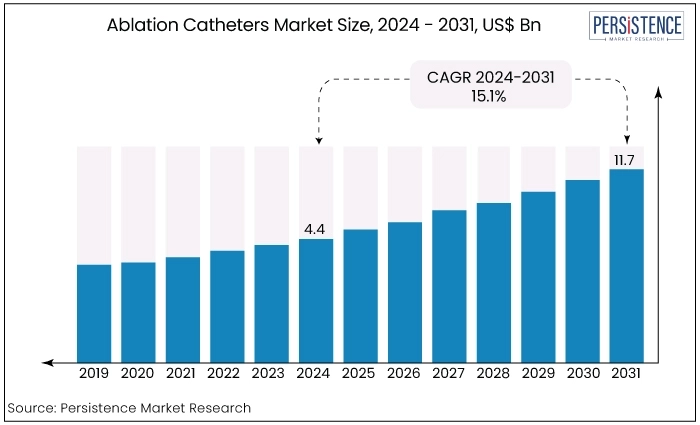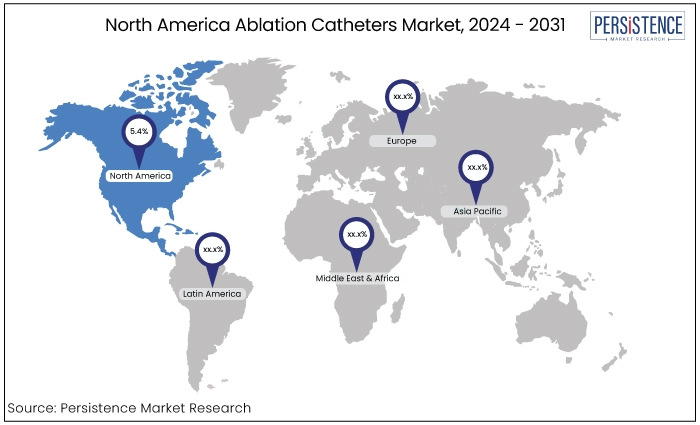Industry: Healthcare
Published Date: September-2024
Format: PPT*, PDF, EXCEL
Delivery Timelines: Contact Sales
Number of Pages: 192
Report ID: PMRREP34758
The ablation catheters market is estimated to value at US$11.7 Bn by the end of 2031 from US$4.4 Bn recorded in 2024. The market is expected to secure a CAGR of 15.1% during the forecast period from 2024 to 2031.

Key Highlights of the Market
|
Market Attributes |
Key Insights |
|
Market Size (2024E) |
US$4.4 Bn |
|
Projected Market Value (2031F) |
US$11.7 Bn |
|
Global Market Growth Rate (CAGR 2024 to 2031) |
15.1% |
|
Historical Market Growth Rate (CAGR 2019 to 2023) |
13.5% |
|
Region |
CAGR through 2031 |
|
North America |
5.4% |
North America is expected to account for significant share in the market. Region's dominance is attributed to several key factors including a high prevalence of atrial fibrillation (AF) and other arrhythmias, advanced healthcare infrastructure, and significant investments in medical technology.
Hospitals and specialized cardiac centers in North America are equipped with state-of-the-art electrophysiology labs that support the growing demand for ablation procedures. Also, the region benefits from robust healthcare policies, widespread adoption of innovative technologies, and substantial research and development activities.
The presence of leading market players and a high level of healthcare expenditure further bolster North America's leading position in the ablation catheter market. As the demand for effective cardiac interventions continues to rise, North America remains at the forefront of market growth and technological advancements.

|
Region |
CAGR through 2031 |
|
Asia Pacific |
6.5% |
Asia Pacific is poised to exhibit CAGR in the ablation catheters market. This growth is driven by increasing prevalence of atrial fibrillation (AF) and other arrhythmias, and rising healthcare infrastructure investments across countries like China, India, and Japan.
There is a heightened demand for innovative and effective ablation therapies as awareness about advanced cardiac treatments grows and healthcare systems in these countries continue to expand. The region's rapid urbanization, improving healthcare access, and increasing disposable incomes contribute to the growing adoption of ablation catheters.
Supportive government initiatives and collaborations with global medical technology companies are fostering market expansion. Asia Pacific region's dynamic healthcare landscape makes it a significant area for growth in the ablation catheter market reflecting its evolving role in global cardiac care advancements.
|
Category |
Projected CAGR through 2031 |
|
Type - Radiofrequency Ablation |
5.2% |
The radiofrequency ablation type is set to capture a significant share. Radiofrequency ablation, known for its effectiveness in treating atrial fibrillation (AF) and other arrhythmias remains a preferred choice due to its established efficacy and safety profile. This technique uses high-frequency electrical currents to destroy abnormal heart tissue providing long-term relief from arrhythmias.
Popularity of this technique is driven by advances in technology that enhance precision and reduce procedural risks. RF ablation's ability to offer real-time imaging and its compatibility with minimally invasive techniques contribute to its dominance in the market.
As demand for effective and less invasive cardiac interventions grows, the RF ablation segment is expected to maintain its leading position supported by ongoing innovations and expanding clinical applications.
|
Category |
Projected CAGR through 2031 |
|
End User - Inpatient Facilities |
6.3% |
Inpatient facilities are anticipated to see significant growth as key end user. These facilities, include specialized cardiac care units and hospitals that are essential for performing complex and high-risk procedures like catheter ablation for atrial fibrillation (AF) and other arrhythmias.
The increasing prevalence of AF coupled with advancements in ablation technology drives the need for specialized inpatient care settings equipped with advanced electrophysiology labs. Inpatient facilities provide the comprehensive care required for patients undergoing ablation procedures, including pre-procedure assessment, real-time monitoring, and post-procedure recovery.
The demand for ablation catheters in inpatient settings is expected to rise significantly as healthcare providers focus on enhancing treatment outcomes and managing severe arrhythmias more effectively. This growth reflects the increasing complexity of cardiac care and the pivotal role of inpatient facilities in delivering high-quality interventional treatments.
The ablation catheters market is primarily driven by the growing prevalence of arrhythmias, particularly atrial fibrillation (AF). Ablation catheters are critical tools used in interventional cardiology to treat abnormal heart rhythms by delivering targeted energy to destroy problematic cardiac tissue, thereby restoring normal heart rhythm.
The market for ablation catheters is characterized by significant advancements in technology and innovation. Modern ablation catheters incorporate sophisticated features such as real-time imaging, advanced mapping systems, and enhanced safety mechanisms, which have significantly improved procedural outcomes and patient safety.
Technological advancements are fueled by continuous research and development efforts aimed at increasing the efficacy of catheter-based interventions and expanding their indications beyond atrial fibrillation to other arrhythmias.
A key driver for the market growth is the increasing incidence of AF with an estimated 33 million individuals affected globally and the incidence expected to double by 2050. This increasing prevalence underscores the demand for effective and efficient treatment options. Growing awareness of the benefits of early and aggressive treatment strategies coupled with supportive clinical guidelines further propels the adoption of ablation procedures. Despite its growth potential, the market faces challenges such as high procedural costs, risks associated with the procedures, and variability in healthcare access.
Opportunities abound in emerging markets, where healthcare infrastructure development and rising awareness are expected to drive demand. Additionally, ongoing innovations in catheter design and integration with digital health technologies present significant opportunities for market expansion.
The ablation catheters market has experienced significant growth over the past few decades, largely driven by the rising prevalence of cardiac arrhythmias, particularly atrial fibrillation (AF). Treatment options for AF were limited to medications that primarily focused on symptom management rather than addressing the underlying electrical disturbances.
The advent of ablation catheters revolutionized the treatment landscape, offering a minimally invasive solution to correct abnormal heart rhythms by precisely targeting and ablating problematic cardiac tissue.
The focus afterwards shifted toward enhancing procedural outcomes through the integration of cutting-edge technologies like real-time imaging, high-density mapping systems, and robotics. These advancements not only improved the precision and success rates of ablation procedures but also broadened their applicability to a wide range of arrhythmias beyond AF.
The market is poised for continued growth fueled by several factors. The global burden of atrial fibrillation is projected to double by 2050 creating a substantial patient pool in need of effective treatment.
Ongoing innovations in catheter design such as the development of next-generation, contact-force sensing catheters are expected to further enhance procedural safety and efficacy driving market expansion. Also, emerging markets present a significant growth opportunity as healthcare infrastructure improves and awareness of advanced arrhythmia treatments increases.
Rising Demand for Ablation Catheters Amidst Increasing AF Prevalence
The ablation catheters market is poised for significant growth driven by the escalating prevalence of atrial fibrillation (AF). Currently, an estimated 33 million individuals globally are affected by AF and this figure is expected to double by 2050.
As AF incidence rises, so does the demand for effective treatment options including ablation catheters. Ablation therapy offers a promising solution for patients who do not respond well to medication, addressing the need for more aggressive and effective treatment strategies.
The expanding patient population underscores a burgeoning market opportunity despite only 9% of eligible AF patients currently receiving ablation therapy. As awareness grows and technological advancements continue, the adoption of ablation catheters is likely to surge, positioning the market for substantial growth in the coming years.
Guidelines and Awareness Boost Ablation Catheter Market
Both patients and healthcare providers are opting for aggressive treatment strategies as knowledge about AF's risks and complications spreads. Updated clinical guidelines now emphasize earlier intervention often recommending catheter ablation as a first-line therapy for select patients.
Shift in treatment approach is driven by the recognition that timely ablation can significantly reduce the risk of stroke and other AF-related complications. The growing emphasis on proactive management coupled with patient education efforts is driving great adoption of catheter ablation procedures. As these trends continue, the ablation catheter market is poised to benefit from heightened demand reinforcing its role in modern AF treatment strategies.
Safety Concerns Impact Ablation Catheter Adoption
While ablation catheters offer a promising solution for atrial fibrillation (AF), the market faces challenges due to the procedural risks and complications associated with their use. Despite the low overall mortality rate of 0.22% within 90 days’ post-ablation, the potential for adverse events including sudden death and procedural complications can deter both patients and healthcare providers.
Complications are rare-occurring in just 0.06% of cases-the severity of possible outcomes such as stroke, cardiac tamponade, and esophageal injury raises concerns. These risks can influence the decision-making process, particularly for patients who might be hesitant to undergo an invasive procedure. As a result, the uptake of ablation catheter treatments may be impacted slowing the growth of the market.
Revolutionizing Patient Care with Digital Ablation Catheters
The integration of ablation catheters with digital health technologies presents a transformative opportunity in the market. By incorporating advanced imaging and remote monitoring systems, healthcare providers can enhance precision during procedures and improve patient outcomes.
Digital tools allow for real-time data analysis and feedback enabling more personalized and effective treatment strategies. With the rise of telemedicine and remote patient management, the ability to monitor patients’ post-procedure from a distance reduces the need for frequent in-person visits.
The integration of artificial intelligence and machine learning algorithms with ablation catheters can aid in predicting complications, optimizing treatment plans, and refining procedural techniques. This convergence of digital health with interventional therapies is poised to drive significant advancements in the ablation catheter market.
Broadening Horizons for Ablation Catheters
The ablation catheter market is poised for significant growth as clinical indications expand beyond atrial fibrillation (AF) to encompass a wider range of arrhythmias. As healthcare providers recognize the efficacy of catheter ablation in treating conditions such as ventricular tachycardia, and supraventricular tachycardia, the demand for these devices is expected to rise.
As clinical guidelines evolve and endorse ablation for a broad spectrum of cardiac issues, the adoption of ablation catheters is likely to increase. This not only boosts market growth but also enhances patient outcomes by providing more effective and targeted treatment options for a variety of arrhythmias. The future of ablation catheters lies in their versatility and ability to address diverse cardiac challenges.
Acquisitions and partnerships, along with the development of innovative products and the expansion of production capacities, are key growth strategies followed by major players in the ablation catheters market. Key players are consolidating their positions through mergers and acquisitions.
Strategic partnerships with technology firms and research institutions are common to drive innovation and enhance product offerings. These collaborations help in accessing new technologies and expanding market reach.
Recent Developments in the Ablation Catheters Market
|
Attributes |
Details |
|
Forecast Period |
2024 to 2031 |
|
Historical Data Available for |
2019 to 2023 |
|
Market Analysis |
US$ Billion for Value |
|
Key Regions Covered |
|
|
Key Market Segments Covered |
|
|
Key Companies Profiled in the Report |
|
|
Report Coverage |
|
|
Customization & Pricing |
Available upon request |
By Type
By End User
By Region
To know more about delivery timeline for this report Contact Sales

Advancements in catheter technology, and the integration of digital health technologies are the key drivers for market growth.
Growing adoption of minimally invasive procedures is a key trend in the market.
The market is estimated to be valued at US$4.4 Bn in 2024.
North America to account for the significant share in the market.
Inpatient facilities are estimated to record a 6.3% CAGR in the market.